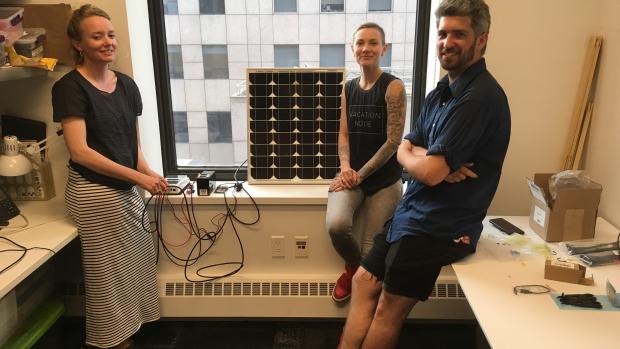Reimagining the internet
A team from Tandon’s Integrated Design & Media program asks, “What if . . .?”

Industry Assistant Professor Tega Brain, Industry Associate Professor Benedetta Piantella, and Adjunct Assistant Professor Alex Nathanson (M.S. '19)
What might the internet look like if it didn’t rely on fossil fuels? What if the internet was completely powered by solar energy? The immediate answer might be that such a system is totally impractical: what happens after the sun sets and the servers lose power? Will web content be available in one part of the world and not another at any given time?
Industry Assistant Professor Tega Brain, Adjunct Assistant Professor Alex Nathanson (a 2019 Integrated Digital Media alum, now Integrated Design & Media, currently writing a book on the history of solar power art and design), and Industry Associate Professor Benedetta Piantella acknowledge that as a society we urgently need to eliminate fossil fuels. Their project, Solar Protocol, is an aesthetic exploration that invites participants to think differently about the energy landscape. Our current cultural and technological status quo, they point out, emerges from, and could be constrained by, the availability of cheap fossil energy, so what might happen if that were taken out of the equation?
Take, for example, the artificially intelligent systems now being used by courts, financial institutions, and hiring firms to make decisions that affect all our lives: those rely on massive datasets produced by tracking and surveillance that are only possible in a society powered by abundant energy. Consider, as well, platforms like Facebook, which continually use energy to monitor what you are viewing and present you with new content based on that.
With Solar Protocol, by contrast, decisions about what content is served would be automated with a logic produced by the sun’s position. The work leverages a natural intelligence that emerges from the intermittent dynamics of our shared environment — poetically reconfiguring internet protocols and creating space to reimagine the relationships we have with the social and technical systems we engage with online.
Earlier this year Solar Protocol won a Phase 1 “Rapid Response for a Better Digital Future” fellowship from the Eyebeam Foundation, which asked artists and technologists to envision and build projects that lay the groundwork for a more humane future. The project then garnered a Phase 2 grant of $25,000 that will allow the team to scale their project from prototype to pilot, working with remote hosts to install servers at their locations.
On February 18, Solar Protocol officially launched during “From the Rupture: Ideas and Actions for the Future,” a showcase mounted by the EyeBeam Foundation.
Thanks to their phase-two grant, the team had arranged for their solar-powered servers to be installed in locations around the world. Consisting of a 50W photovoltaic panel and a rugged, weatherized box containing all the required hardware, each unit is now being overseen by a “server steward” in Australia, Canada, Chile, Dominica, or the U.S.
During the EyeBeam event, Brain, Nathanson, and Piantella discussed the impetus for the project, explained its technical specifications, and introduced the stewards, many of them fellow professors who had set up the servers at their own universities. Watch their 10-minute presentation at the 2:39:55 timestamp, and for even more details on the project, visit solarprotocol.net.
Because they ultimately aim to build a field of practice around solar-powered media and explore the worlds it makes possible, they’re currently seeking additional stewards in different time zones and continents, so if you are interested in helping, visit solarprotocol.net/call for more information.





